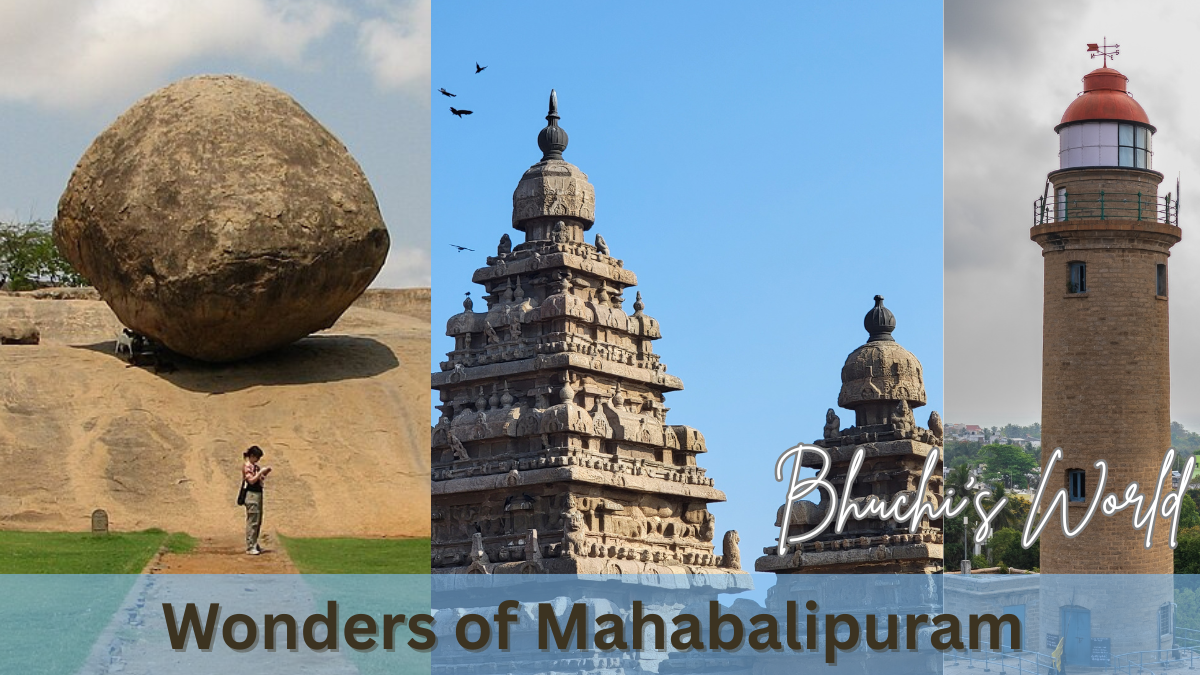Have you ever stood in a place so ancient, so surreal, that you felt like time just… paused?
Welcome to Mahabalipuram, the coastal town where history isn’t just remembered, it’s carved into stone, standing tall for you to see, touch, and wonder. Nestled along Tamil Nadu’s scenic shoreline, this UNESCO World Heritage Site invites you to explore monuments that are not only centuries old but also bursting with stories, legends, and jaw-dropping artistry.
As you wander through Mahabalipuram, you won’t just be ticking landmarks off a list; you’ll be stepping into the very footprints of South Indian kings, watching ancient tales come alive in granite. You’ll marvel at the Shore Temple, standing proud against crashing waves, and puzzle over how Krishna’s Butter Ball, a massive boulder, balances on a slope like it’s been super-glued by the gods.
And trust me, you’ll have questions. How did people build such massive structures with such precision over 1,300 years ago? What secrets do these carvings whisper? Why is this place so magnetically peaceful?
So grab your sunhat, lace up those walking shoes, and get ready—because what you’re about to see in Mahabalipuram is nothing short of a spiritual and artistic rollercoaster. Let’s unlock the 7 stunning wonders of Mahabalipuram that make this town a treasure chest of ancient glory.
Shore Temple: The Iconic Sentinel by the Sea
As you walk along the breezy shores of Mahabalipuram, there’s one monument you simply can’t miss—the Shore Temple. Rising gracefully against the backdrop of crashing waves and golden sands, this ancient granite structure has guarded the Bay of Bengal for over 1,300 years. It’s not just a temple; it’s a legend sculpted in stone.
So why is it so special?
Well, for starters, it’s the oldest structural stone temple in South India, built by King Narasimhavarman II of the Pallava dynasty around the 8th century. Unlike the rock-cut caves and monoliths nearby, the Shore Temple was constructed block by block using finely cut granite—a major shift in temple architecture that paved the way for the grand temples of Tamil Nadu you see today.
When you stand in front of it, you’ll notice two shrines—one dedicated to Lord Shiva and another to Lord Vishnu. That’s right. This temple brings together two powerful Hindu deities under one roof, showcasing a rare confluence of divine worship that was way ahead of its time.
But here’s what gives the Shore Temple its aura: it’s a living example of ancient resilience. Despite salty sea winds, cyclones, and centuries of weathering, it still stands tall, like it was built yesterday. In fact, during the 2004 tsunami, locals reported seeing the remains of submerged temples revealed by the receding waters, reinforcing legends of an underwater temple complex believed to be part of the ancient city of Mahabalipuram.
What makes your visit even more unforgettable is the setting. Picture this—you, the vast ocean, a whispering breeze, and the rhythmic chants of the waves crashing beside a 1,300-year-old monument. You can’t help but feel a deep spiritual calm, a connection to a time when temples were not just places of worship but cosmic bridges between man and the divine.
Here’s a fun fact for you: The Shore Temple is one of the few monuments in India to face the sea rather than a river or land, a nod to Mahabalipuram’s maritime heritage and its significance as a thriving port during the Pallava reign.
When visiting, don’t forget to observe the intricate carvings, from mythological lions to delicate floral patterns. Even after a millennium, the craftsmanship will leave you speechless.
Whether you’re a history buff, a photography lover, or a seeker of spiritual silence, the Shore Temple offers something no photo or video can capture: a moment suspended in time.
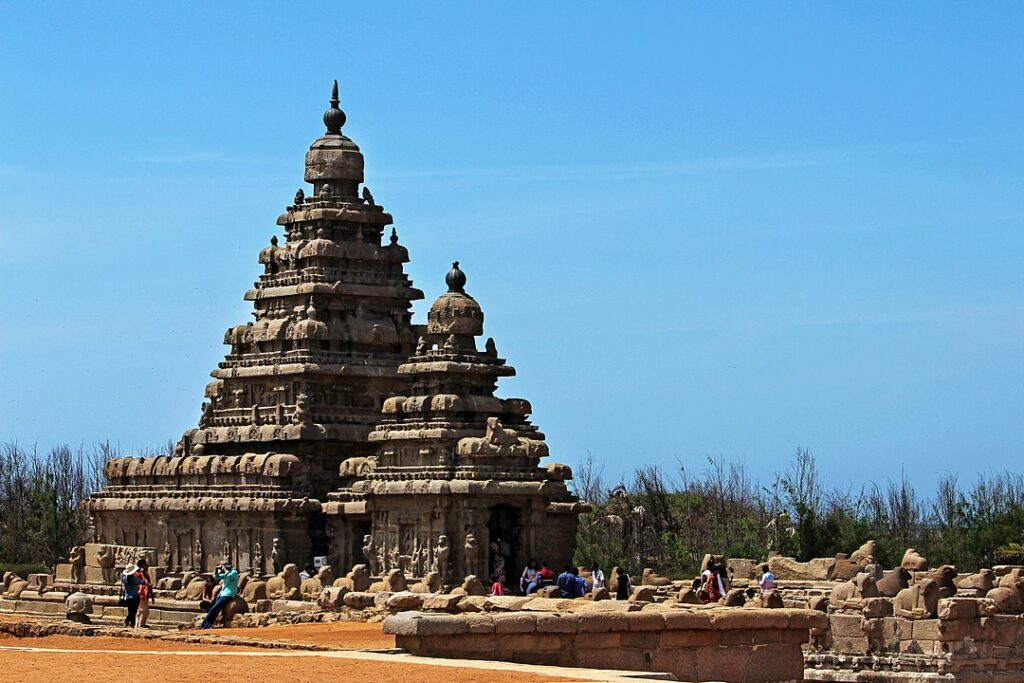
Pancha Rathas: Monolithic Masterpieces of the Pallavas
Imagine an entire chariot, carved from a single piece of rock. Now imagine five of them, each shaped like a different Indian temple style. That’s what awaits you at Pancha Rathas, one of Mahabalipuram’s most mind-blowing sites.
These “rathas,” or chariots, aren’t vehicles; they’re temples carved to resemble ones. Each ratha is named after one of the Pandavas from the Mahabharata, plus their shared wife, Draupadi. But here’s the twist: they were never used for worship. These were experimental structures, blueprints in stone, that helped shape the future of South Indian temple design.
What makes them jaw-dropping is that each one, from Dharmaraja’s tall multi-tiered shrine to Draupadi’s compact hut-like temple, is carved from the same granite bedrock, without separate stones, bricks, or mortar.
As you explore, look out for the fine carvings of lions, elephants, gods, and guardians, still sharp despite centuries of weather. And the elephant next to Nakula-Sahadeva’s Ratha? It’s the best-preserved monolithic elephant from ancient India!
Here’s a fact that’ll stick with you: these temples were left incomplete after the death of King Narasimhavarman I, yet even in their unfinished state, they speak volumes about Pallava artistry and vision.
The layout, variety, and imagination make Pancha Rathas feel like an open-air architecture lab—a place where stone and story come together most poetically.
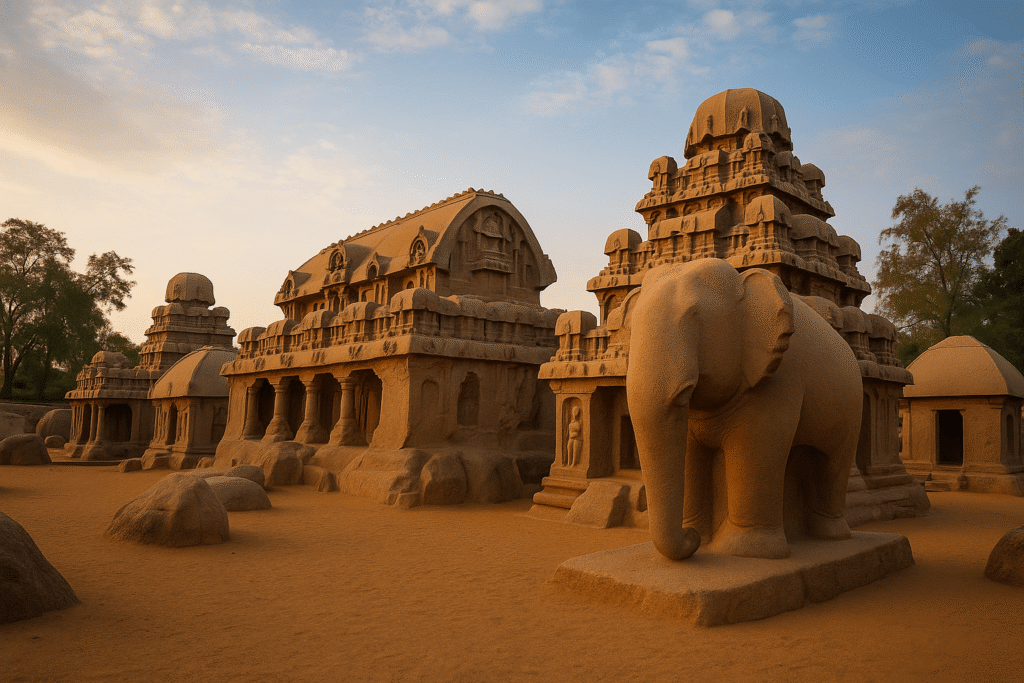
Arjuna’s Penance: A Giant Canvas of Ancient India
Now imagine a massive rock face, 96 feet long and 43 feet high, etched with more than 100 life-sized figures, all telling a story in motion. That’s Arjuna’s Penance, one of the world’s largest open-air rock reliefs and an absolute showstopper in Mahabalipuram.
As you stand before it, the first thing that hits you is the detail. You’ll see gods, celestial beings, animals, and even a family of elephants, so lifelike they seem ready to walk off the stone. Right in the center, there’s a mysterious figure in deep penance. Is it Arjuna from the Mahabharata, praying for a powerful weapon? Or is it Bhagiratha, performing tapas to bring the sacred Ganges to Earth? That dual interpretation is what makes this monument a puzzle wrapped in mythology.
One incredible detail: there’s a natural cleft running down the center of the rock. During monsoons, water trickles through it, symbolizing the descent of the Ganges from the heavens, a brilliant blend of nature and narrative.
This isn’t just art. It’s spiritual storytelling at its finest, where every figure, from the meditating cat pretending to do penance to the mischievous monkeys, has a purpose. Believe it or not, this entire scene was carved in the 7th century without modern tools.
What makes this site so unforgettable is its energy. You’re not just looking at a sculpture; you’re reading a sacred epic in stone, surrounded by nature, history, and awe.
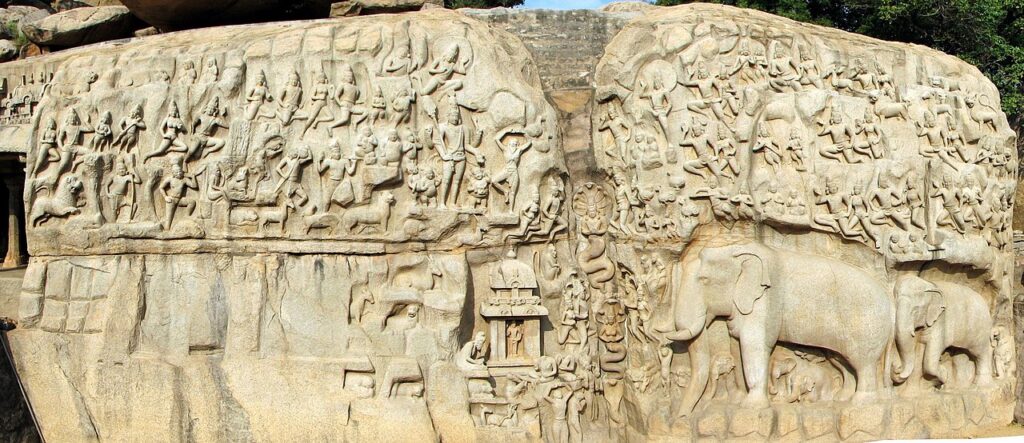
Krishna’s Butter Ball: Gravity-Defying Marvel
Now here’s something that will make you stop in your tracks—a 250-ton boulder, perched on a 45-degree slope, and it hasn’t budged an inch for over 1,200 years! Meet Krishna’s Butter Ball, the natural rock formation that defies logic and gravity all at once.
The locals call it Vaan Irai Kal, meaning “Stone of the Sky God,” and for good reason. The boulder sits so delicately on the slope that you’ll wonder, “How is this even possible?” Go ahead, stand underneath it. Snap a few daring photos. Just don’t try to push it, because even seven elephants couldn’t move it, according to legend!
And while geologists say it may be a natural granite formation caused by erosion, even they admit it’s a mystery how it hasn’t tumbled down the hill in all these centuries. No cement, no foundation, no support, just gravity-defying wonder.
The best part? It’s surrounded by a lush green lawn, making it the perfect picnic spot. Kids roll around in the grass. Adults gaze up in disbelief. And everyone leaves with a sense of awe—and a selfie, of course.
In a town full of temples and carvings, Krishna’s Butter Ball stands out for its pure playfulness. It reminds you that not every Marvel has to be serious; some are just gloriously weird.
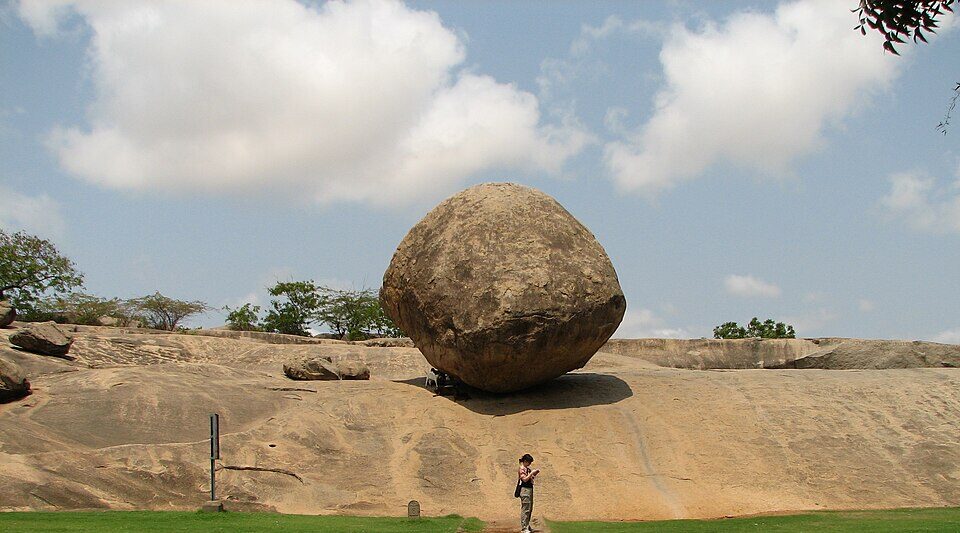
Rock-Cut Temples and Cave Sanctuaries
If you love exploring ancient caves with stories etched into every surface, Mahabalipuram’s rock-cut temples are a dream come true. These aren’t just hollowed-out rocks; they’re sacred spaces carved into cliffs, each a window into the soul of 7th-century India.
Start with the Mahishasuramardini Cave, a true masterpiece. As you enter, you’ll see Goddess Durga mid-battle, slaying the demon Mahishasura with poise and power. The detailing is so vivid, it almost moves! On the opposite side, Lord Vishnu reclines on the serpent Ananta, surrounded by divine guardians. All of this, carved right into the walls!
Another must-see is the Varaha Cave Temple, where Lord Vishnu, taking the form of a boar, lifts the Earth goddess from the cosmic ocean. The figures are bold, muscular, and full of life, making you feel the energy of divine rescue.
And then there’s the Tiger Cave, a bit away from the main group. With tiger heads carved around its entrance, it’s not just artistic—it’s atmospheric. Some believe it was a royal performance hall, blending spirituality with entertainment.
What’s amazing is how these caves blend architecture, mythology, and raw emotion. You’ll walk through stone corridors where monks once meditated, stand under intricately carved panels, and run your fingers over grooves shaped by artisans over a thousand years ago.
And here’s the kicker: all these carvings were made without modern tools. No chisels powered by machines, just human hands, faith, and unmatched skill.
Whether you’re a spiritual seeker, history lover, or art enthusiast, these rock-cut sanctuaries leave you feeling like you’ve stepped into a divine dimension.
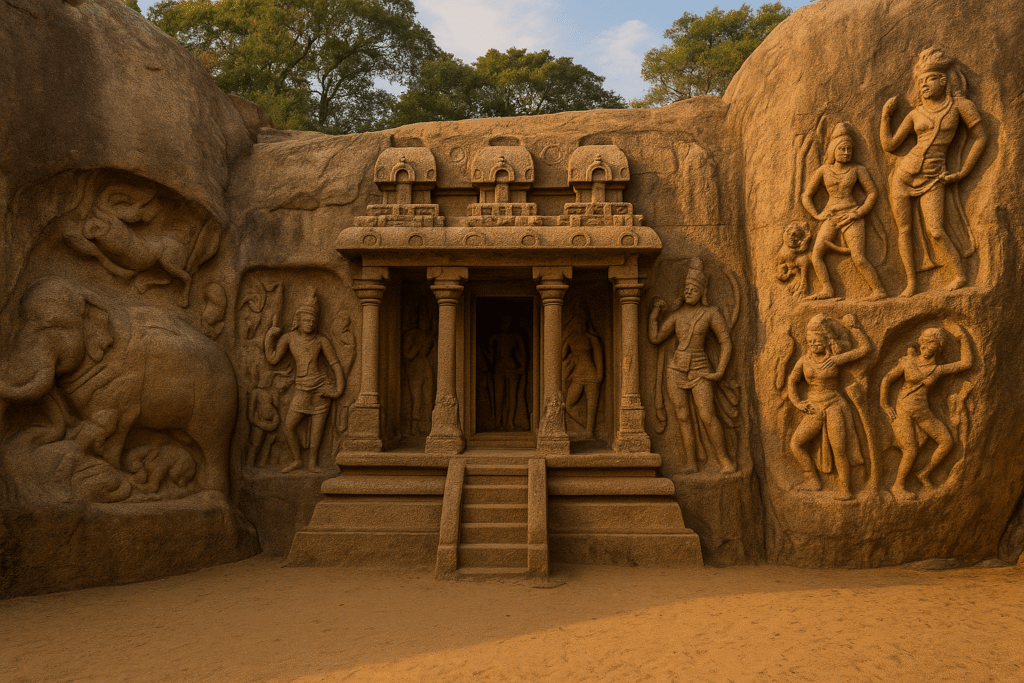
Preserving Mahabalipuram: A Living UNESCO World Heritage Site
As you explore the wonders of Mahabalipuram, it’s easy to forget that these marvels are over 1,300 years old. What’s even more incredible? They’re not hidden in museums—they’re still out in the open, weathering the sun, salt, rain, and time.
In 1984, UNESCO declared Mahabalipuram a World Heritage Site, recognizing it as a priceless cultural treasure. Since then, preservation efforts have stepped up, ensuring that future generations can also walk these same paths and feel the same awe.
But preserving this site isn’t just about cleaning stones. It’s a delicate dance between protecting ancient structures and welcoming thousands of visitors each year. Experts use eco-friendly methods to prevent erosion, remove salt deposits, and protect sculptures from monsoon damage. Meanwhile, signage, guided tours, and walkways help reduce wear from foot traffic.
Interestingly, after the 2004 tsunami, several buried temples were revealed along the coastline, sparking global interest and archaeological efforts. Today, parts of Mahabalipuram are still being studied—meaning you’re walking through an active history lab, not just a tourist spot.
Even more inspiring is how the local community plays a role. From government guides to local sculptors keeping traditional stone-carving techniques alive, Mahabalipuram is a place where heritage isn’t just preserved—it’s practiced.
Want to support the preservation? Stick to marked paths, hire certified guides, and avoid touching delicate carvings. And if you’re curious about the broader efforts, UNESCO’s official World Heritage website offers fascinating details.
Mahabalipuram isn’t just a place to visit—it’s a living monument. By witnessing its magic, you become part of its story.
Conclusion
So there you have it—seven unforgettable wonders of Mahabalipuram that blend mythology, artistry, and history into one spellbinding journey. From the majestic Shore Temple standing tall against the sea, to the mysterious Krishna’s Butter Ball, this coastal town isn’t just a destination—it’s a living museum where every stone has a soul.
You’ve explored towering monoliths, epic rock reliefs, sacred cave shrines, and quirky gravity-defying boulders—all within a space that has stood the test of time for over a millennium. And the best part? Mahabalipuram doesn’t just preserve the past—it invites you to experience it.
Whether you’re a traveler seeking serenity, a photographer chasing golden light, or a history buff hungry for stories, Mahabalipuram offers a deeply personal connection to India’s ancient legacy. It whispers secrets in carvings, echoes legends in its silence, and leaves you with memories etched just as deeply as its stones.
So don’t just read about it—go see it, feel it, live it. Because Mahabalipuram isn’t just a place on the map—it’s a marvel for the heart.
For more immersive travel stories and cultural discoveries, check out Bhuchisworld—your gateway to hidden gems and unforgettable journeys.
Discover more from Bhuchi's World
Subscribe to get the latest posts sent to your email.

